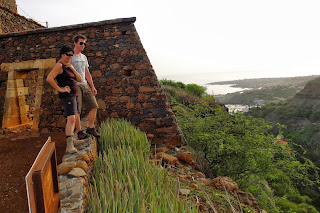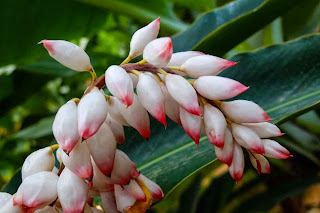On the beach this is the logical summer parallel to our bird protection and bird watching activities in winter.
This year we are very grateful to have the support of The Crowder-Messersmith grant from the Audoubon Society in the USA.
see: http://www.audubonnaturalist.org/index.php/conservation/crowder-messersmith
August is supposed to be a good time to see both turtles laying eggs and hatchlings going back to the sea. But it turned out to be quite difficult to get good shots at night in the sea-spray where flashlight gives you misty pictures. Also no adult turtles appeared for six days in a row.
Only because TAP cancelled our flights and we had to stay 2 nights longer we were "lucky" to see everything we wanted.
The group CARETA has headquarters at "Favela" in Achada Igreja. Here they hold meetings and sleep in the breaks of their nightly patrols.
Also the schedule for the patrols is posted here.
When we came on August 17th they had identified 30 nests. This number seems to indicate a much weaker season than last year. Most nesting sites were just ringed with stones, but some had been removed to a safer place.
Patrols are on the beach day and night.
Some of the nests are protected by nets. This is going to be improved!

Rest on a nightly patrol.
About 80 hatchlings come from each nest. The nests that have been displaced have a poorer result, about 10 - 20% less!
The little ones are put into buckets and counted. Then they are released into the sea.
Whenever a bucketful of hatchlings is to be released children and people from the village gather around to witness the process. Until recently turtles were widely eaten here.
This year there have been two reports of illegal killings on this beach, another four from the wider region.
Armed soldiers are supposed to guard the sand. Taking sand away is forbidden. Illegal sand removal
(also in big style) has led to salt infiltration and a drastic loss in fishes. Now the bored soldiers are happy to have some company during the night watches and assist the Careta people.
Numbers and dates are written down by Djonny who leads the patrols.
The lights of Pedra Badejo in the background.
Field Manager Fredy Cardoso throwing light over the scene.
This young biologst was sent from "Geomar" to support the group. She also brought special
equipment to mark the adult turtles with numbered metal tags and to take a tissue sample.
To prevent the hatchlings from turning towards land-side, man-made lights, one person stands in the water to give them a strong light signal to follow towards the sea.
The only adult turtle we saw:
Obviously this turtle had been disturbed before she could lay eggs and was now returning into the sea. The hole she left in the sand was empty.
On the morning of 26. August: another 51 little ones go back to the sea.

But many eggs had not hatched.

























































